Monads
Recommended reading: Philip Wadler, Monads for functional programming. In Advanced Functional Programming, First International Spring School on Advanced Functional Programming Techniques, Båstad, Sweden, May 24-30, 1995.
Some programming features in imperative languages
- Error handling
- Exceptions (e.g., Java)
- Set some global variable and abort computation (e.g.,
errnoin C)
- Logging
- Writing to a file
- Having a global reference where to store the log
What about in Haskell? (Pure functional language)
Data flow is explicit!
Let us take a concrete example
-- | Abstract syntax data Expr = Con Int | Div Expr Expr -- | Simple interpreter for simple arithmetic expressions interp :: Expr -> Int interp (Con i) = i interp (Div e1 e2) = i1 `div` i2 where i1 = interp e1 i2 = interp e2 -- | Successful division. ex_ok = Div (Con 10) (Con 5)What if we accidentally divide a number by
0?-- | Crashing 'interp'! ex_crash = Div (Con 1) (Con 0)
Handling errors explicitly
The error handling mechanism that we consider is
If something goes wrong, the *whole* computation aborts!(We do not consider recovery options.)
Let us modify the interpreter to implement our error handling mechanism
data E a = Value a -- ^ Regular result. | Wrong -- ^ Exception. interpE :: Expr -> E Int interpE (Con i) = Value i interpE (Div e1 e2) = case interpE e1 of Wrong -> Wrong Value i1 -> case interpE e2 of Wrong -> Wrong Value i2 -> if i2 == 0 then Wrong else Value $ i1 `div` i2
Basically, every recursive call needs to be checked for errors! If one of them fails, then the program should abort.
Consider what would happen if
Exprhad many other recursive constructors.One possible
runfunction:runE :: Expr -> IO () runE e = case interpE e of Wrong -> putStrLn "Something went wrong!" Value i -> putStrLn $ show i
Logging
- We want to create a trace of the program:
- Send messages to a log.
- This information could be used to improve future interpreter optimizations
or detection of bugs.We want to send messages to a log at every instruction.
Let us modify the interpreter to log the number of divisions.
data L a = L a [String] interpL :: Expr -> L Int interpL (Con i) = L i ["-- Hit Con --"] interpL (Div e1 e2) = L (i1 `div` i2) $ concat [ [ "-- Hit a Div --" ] , [ "** Left recursive call **" ] , msgs1 , [ "** Right recursive call **" ] , msgs2 ] where L i1 msgs1 = interpL e1 L i2 msgs2 = interpL e2
- Basically, the results of every recursive call* needs to be inspected to obtain the corresponding logs.
- Consider what would happen if
Exprhad many other recursive constructors. - One possible run function:
runL :: Expr -> IO () runL e = do putStr "The result is: " putStrLn $ show i putStrLn "Log:" mapM_ putStrLn msgs where L i msgs = interpL e
Side-effects & pure functional programming
| Imperative programming | Pure functional programming |
|---|---|
| Error handling | Plumbing (check if any subcomputation has failed) |
| Logging | Plumbing (consider subcomputations' logs) |
Monads
What are monads?
- Structures useful to write programs with side effects.
What is so special about them?
They are general (support many different side-effects).Monads hide the plumbing (simplifies code).How can they be so general?
Monads control the order of evaluation.Roughly speaking, the trick is how sequencing `;` is defined! Different definitions for `;` allow to handle different side-effects.
Construction of programs
Programs can be conceived as a sequence of instructions put together.
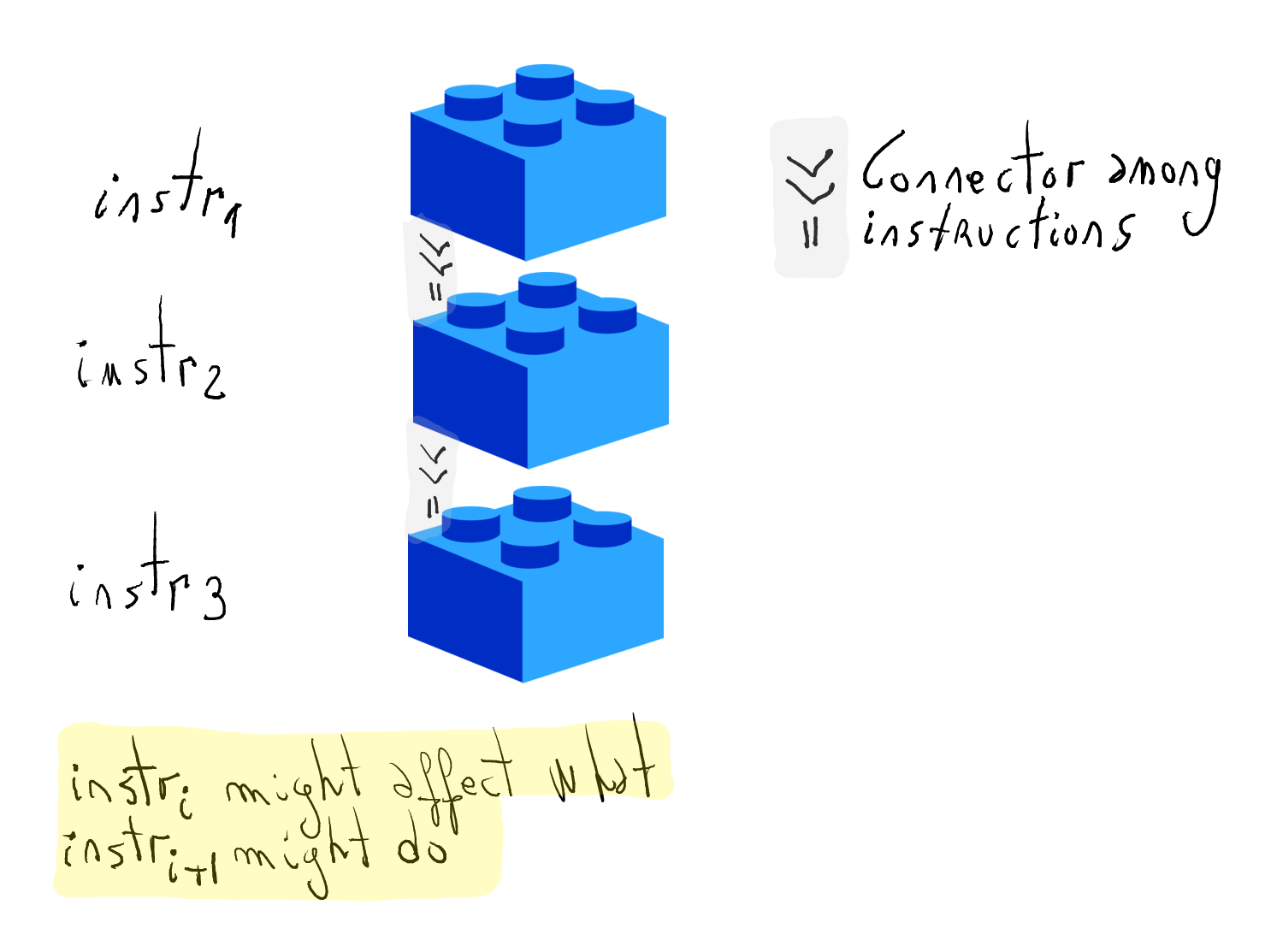
Every instruction computes some data
Importantly, an instruction can affect what subsequent ones do. More precisely,
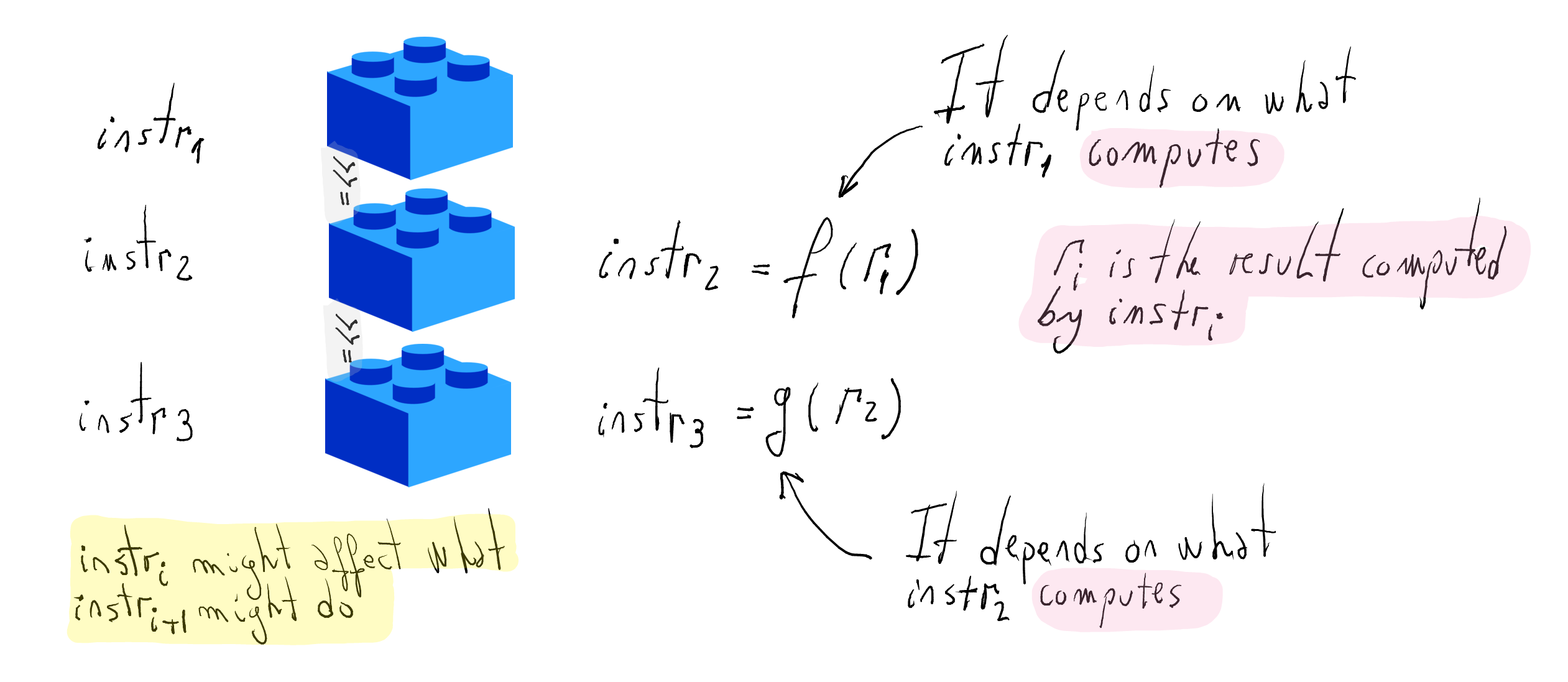
Functions
f(r1)andg(r2)encode the dependency among instructions.What are the types for
fandg, respectively?Let us first introduce the types for instructions.
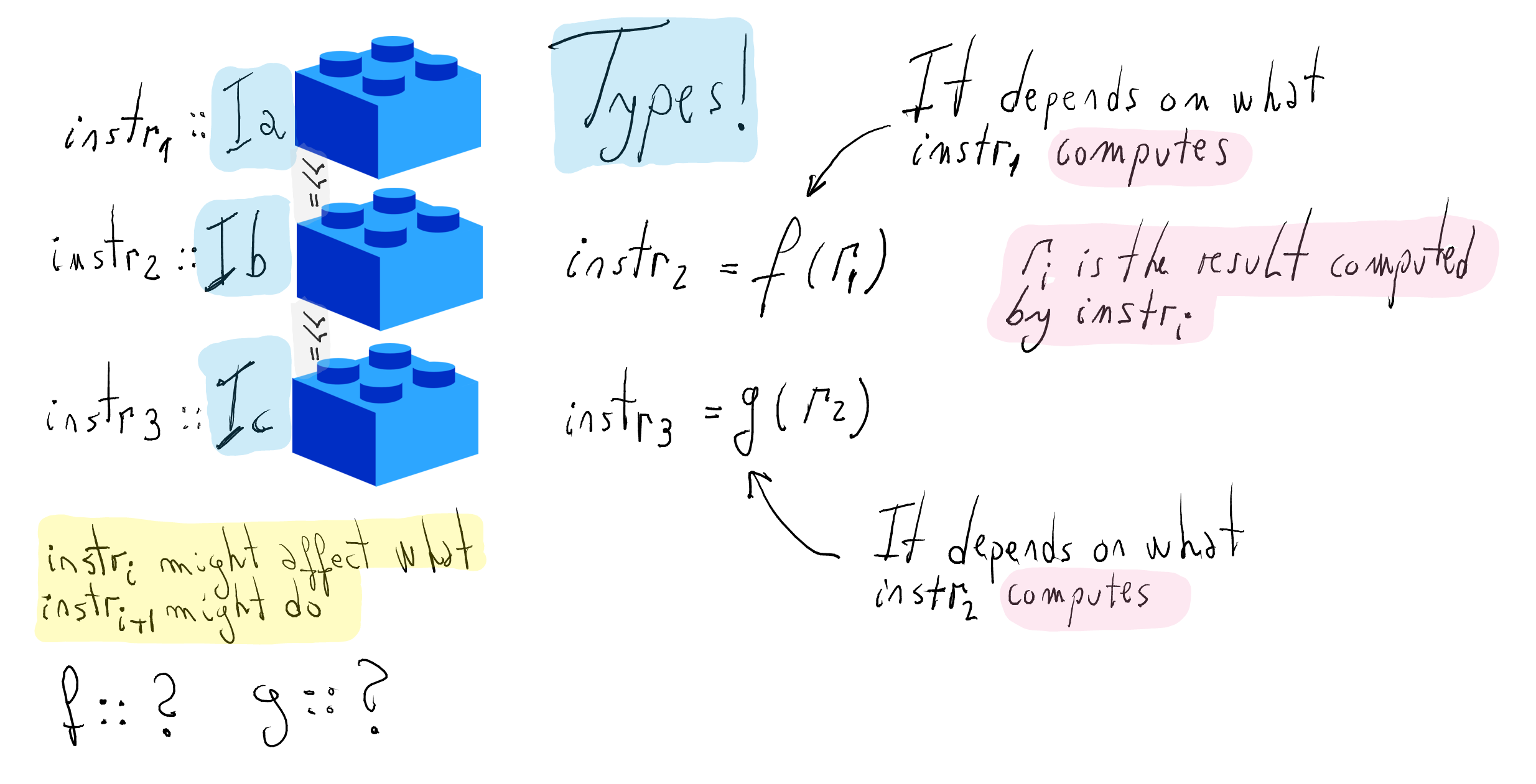
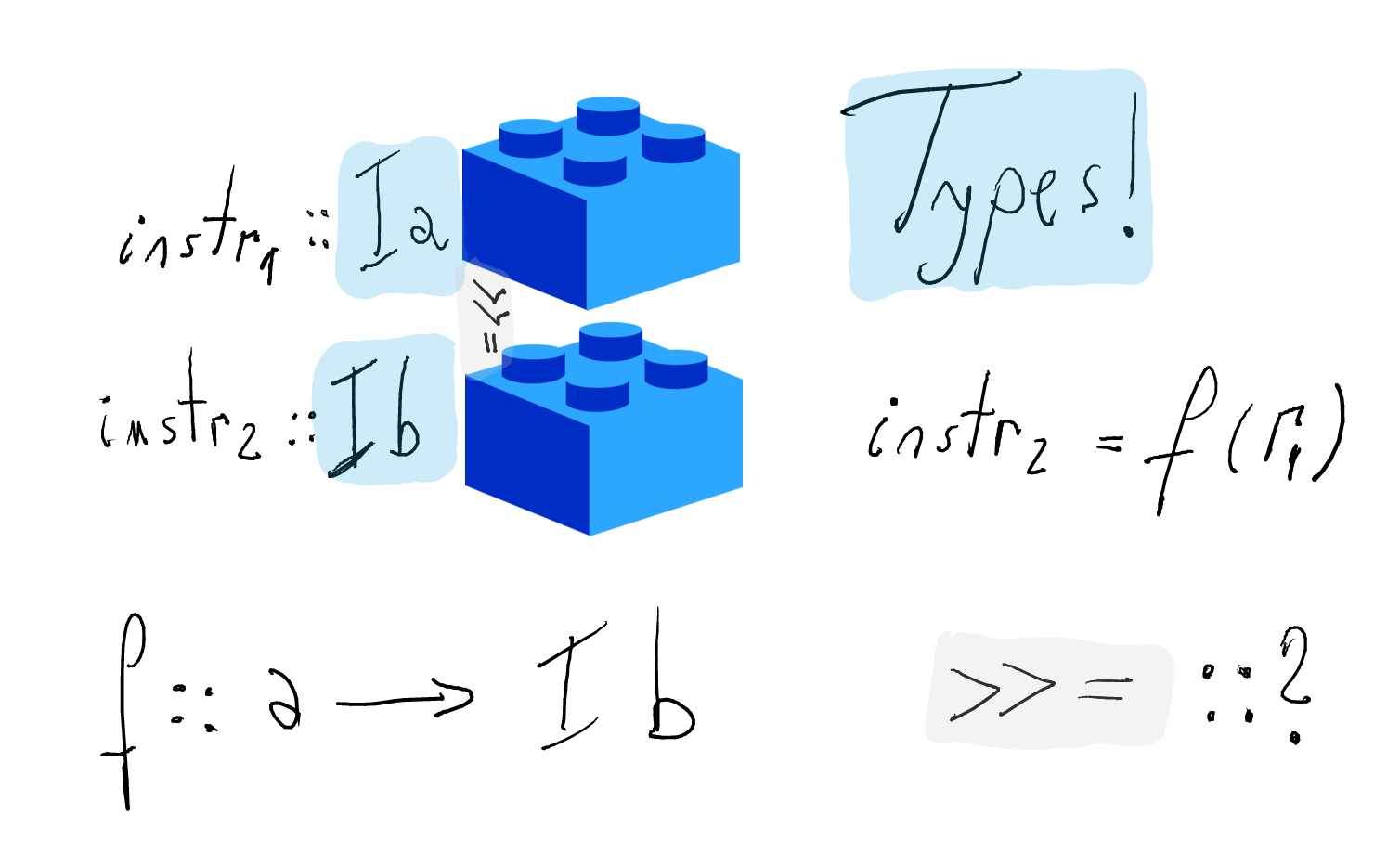
What is the type of the connector
(>>=)?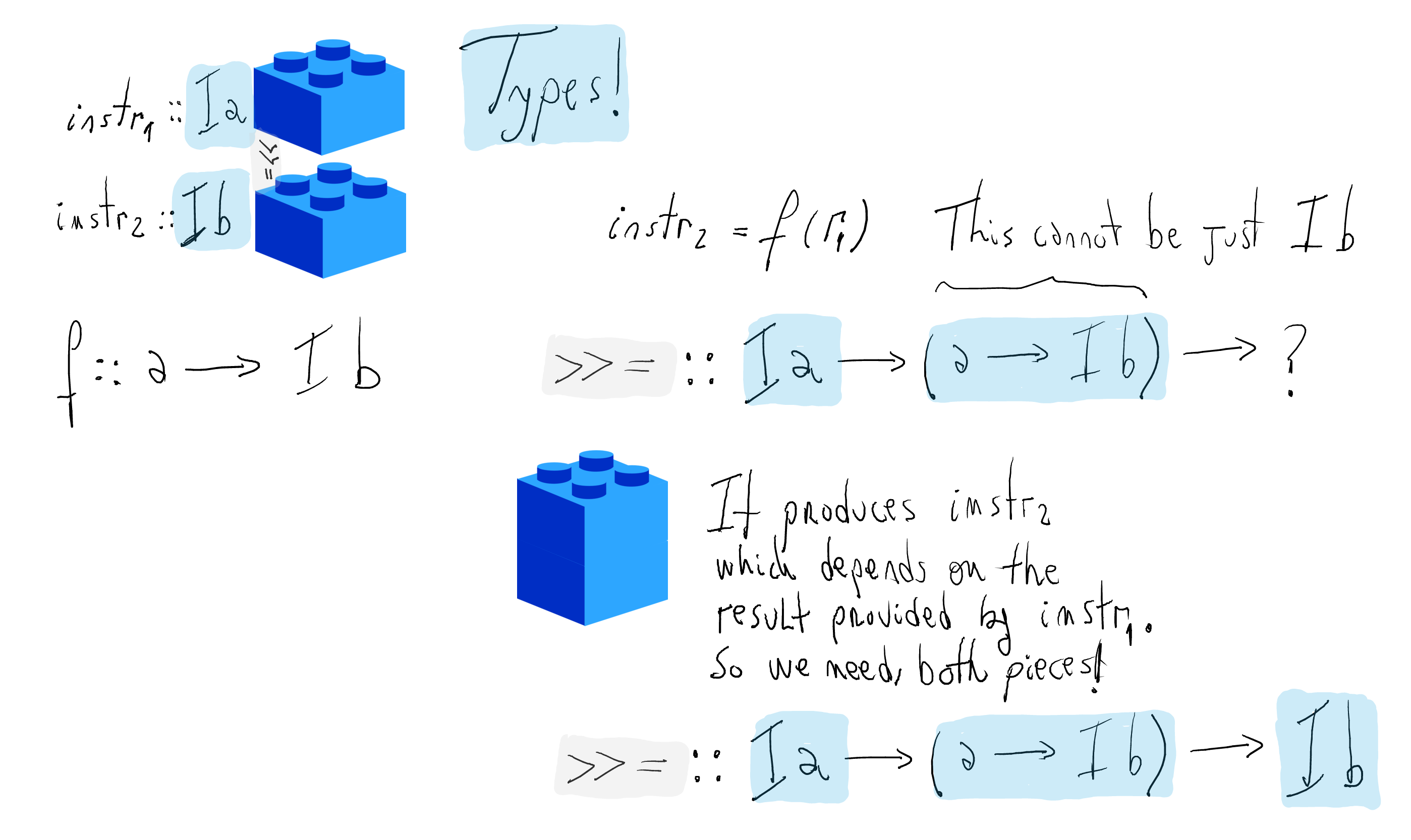
Error handling
The connector is placed in the "right place" to abort any computation as soon as an instruction fails.
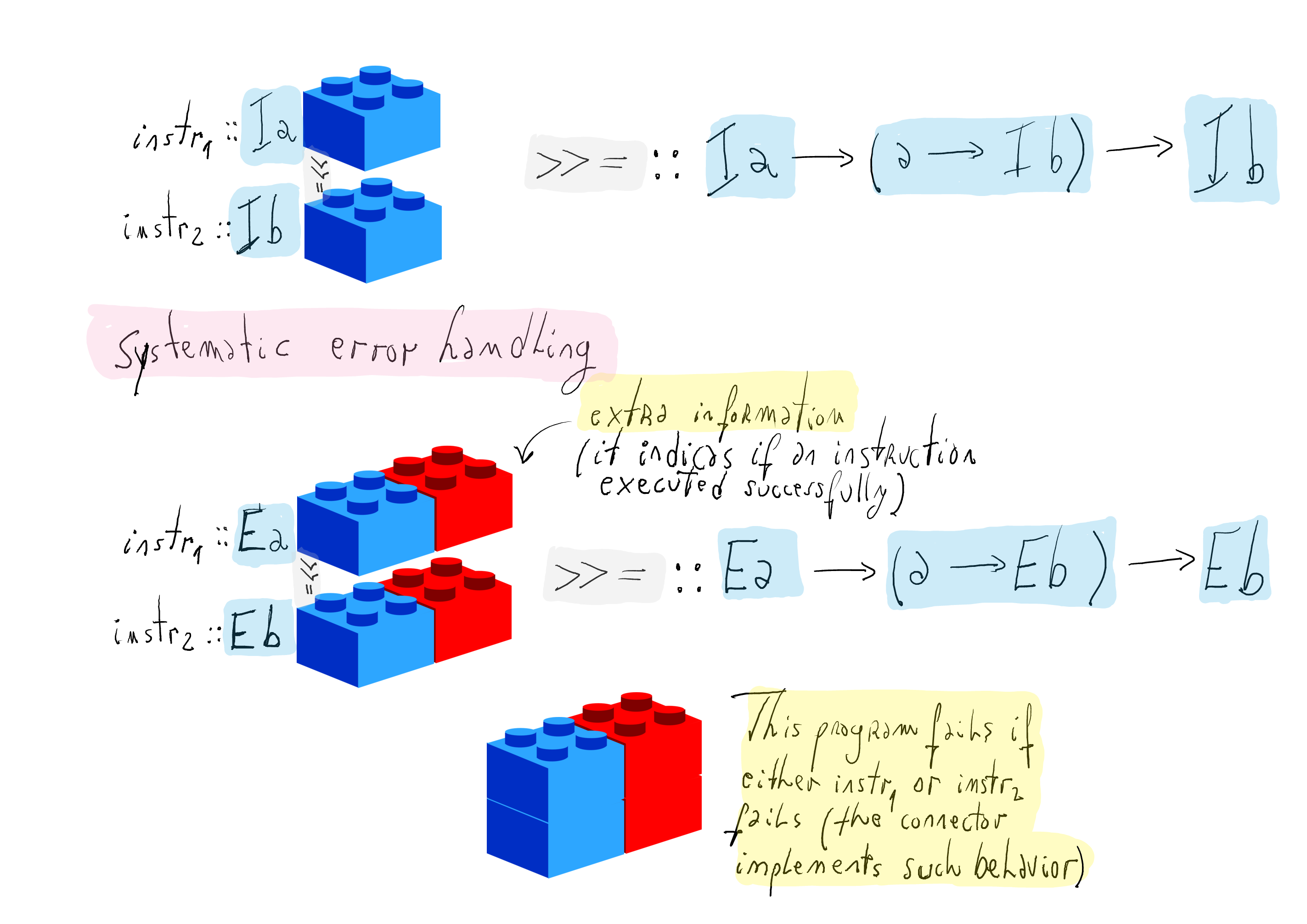
A data type for handling errors:
data E a = Value a | Wrong
Is
E aa monad?- Not yet, we need to define the connector
(>>=). - Furthermore, monads have another primitive:
return. This primitive takes a value and constructs an instruction that does nothing but producing that value.
- Not yet, we need to define the connector
In Haskell, a type constructor
mis a monad ifreturnand(>>=)are provided:class Monad m where return :: a -> m a (>>=) :: m a -> (a -> m b) -> m b
What is the implementation of
returnand(>>=)forE a?instance Monad E where return = Value Wrong >>= f = Wrong Value a >>= f = f a
Monad
Eis known as theMaybemonad.We need to add a primitive to make everything fail:
abort :: E a abort = Wrong
This function is known as a non-proper morphism. In other words, non-proper morphisms are operations which are not
returnand(>>=). They handle or affect the side-effectful part of the computation (in the case above, the failure!)The run function is mostly unchanged:
m_runE :: Expr -> IO () m_runE e = case m_interpE e of Wrong -> putStrLn "Something went wrong!" Value i -> putStrLn $ show i
Error handling in the interpreter
Let us rewrite the interpreter using the monad
Em_interpE :: Expr -> E Int m_interpE (Con i) = return i m_interpE (Div e1 e2) = m_interpE e1 >>= \ i1 -> m_interpE e2 >>= \ i2 -> if i2 == 0 then abort else return (i1 `div` i2)Observe that the code has minimum traces of error handling, i.e., it need not (explicitly) inspect every recursive call for an error.
- It is handled by the monad!
- All the plumbing is hidden!
Logging
We would like to be able to control what information gets logged.
We want to implement the side-effect of logging, i.e., the program computes the result of arithmetic expressions and, as a side-effect, generates a log of messages.
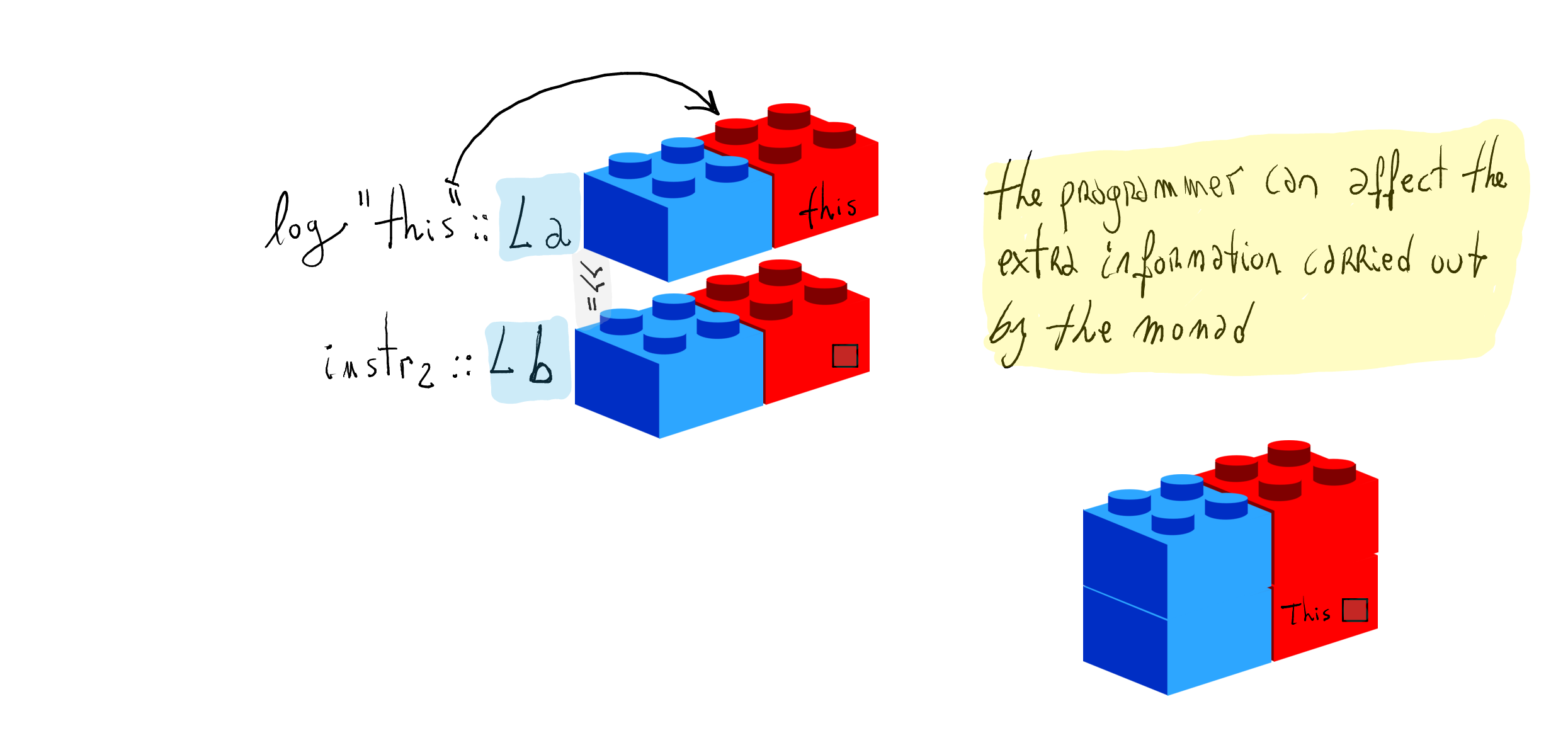
Let us define
returnand(>>=)forL:instance Monad L where return x = L x [] L x msgs1 >>= f = case f x of L y msgs2 -> L y (msgs1 ++ msgs2)- Function
returnproduces the empty lists of logs (no side effect). - Function
(>>=)concatenates the logs.
- Function
We need to implement a non-proper morphism which writes into the log -- we call it
msg.msg :: String -> L () msg m = L () [m]
Let us rewrite the interpreter using the monad
L:m_interpL (Con i) = msg "-- Hit Con --" >>= \ _ -> return i m_interpL (Div e1 e2) = msg "-- Hit a Div --" >>= \ _ -> msg "** Left recursive call **" >>= \ _ -> m_interpL e1 >>= \ i1 -> msg "** Right recursive call **" >>= \ _ -> m_interpL e2 >>= \ i2 -> return (i1 `div` i2)Observe that the code has minimum traces about how the log is constructed.
- It is handled by the monad!
- All the plumbing is hidden!
- It looks like imperative programming!
Observe that we use many times
m >>= \ _ -> ...whenmdoes not produce a useful value for the computation but a useful side-effect! (in this case, logging)Monads use the operation
(>>)to capture such situation and save us from writing functions which ignore arguments.(>>) :: m a -> m b -> m b m1 >> m2 = m1 >>= \ _ -> m2
Observe that function
(>>)is a derived operation.Let us rewrite the interpreter once more
m_interpL (Div e1 e2) = msg "-- Hit a Div --" >> msg "** Left recursive call **" >> m_interpL e1 >>= \ i1 -> msg "** Right recursive call **" >> m_interpL e2 >>= \ i2 -> return (i1 `div` i2)The run function is mostly unchanged.
m_runL :: Expr -> IO () m_runL e = do putStr "Result: " putStrLn $ show result putStrLn "Messages:" mapM_ putStrLn log where L result log = m_interpL e
Enter Monads
Definition
A data type
mis a monad if it supports the following two operations:(>>=) :: m a -> (a -> m b) -> m b return :: a -> m a
Functions
returnand(>>=)are known as return and the bind operations, respectively.Furthermore, these operation are required to fulfill the next laws:
Name Law Left identity: return a >>= f ≡ f a
Right identity: m >>= return ≡ m
Associativity: (m >>= f) >>= g ≡ m >>= (\ x -> f x >>= g)
Exercise: Check thatEandLrespects these laws.Terminology
- Monadic simply means pertaining to monads.
- A monadic type has the form
m awheremis an instance of theMonadtype class; a monadic value has a monadic type.
Notation
Writing code with bind can look bloated:
m1 >>= \ r1 -> m2 >>= \ r2 -> m3
Haskell supports do-notation, to write monadic code in "imperative style".
do r1 <- m1 r2 <- m2 m3
Similarly,
m1 >> m2 >>= \ r2 -> m3
can be written as
do m1 r2 <- m2 m3
Revising interpreters with do-notation
Error handling
m_interpE :: Expr -> E Int m_interpE (Con i) = return i m_interpE (Div e1 e2) = do i1 <- m_interpE e1 i2 <- m_interpE e2 if i2 == 0 then abort else return (i1 `div` i2)Logging
m_interpL :: Expr -> L Int m_interpL (Con i) = do msg "-- Hit Con --" return i m_interpL (Div e1 e2) = do msg "-- Hit a Div --" msg "** Left recursive call **" i1 <- m_interpL e1 msg "** Right recursive call **" i2 <- m_interpL e2 return (i1 `div` i2)
It looks and feels like imperative programming (but it is not!)
Monads alleviate all the explicit data flow required to implement error handling and logging.
Monads and EDSL?
In our examples above, we talk about monadic types, constructors, combinators, non-proper morphisms, and run functions:
-- Types data E Int -- Constructors return :: Int -> E Int abort :: E Int -- Combinators (>>=) :: E Int -> (Int -> E Int) -> E Int -- Run function m_runE :: Expr -> IO ()
The type
Eand monadic operationsreturnand(>>=)are polymorphic; in fact, monads require them to be (recall the type classMonad). However, when instantiate them to the type that we are interested in, i.e., in this caseInt, we have a EDSL!- Monads are also useful to define EDSL in Haskell, but not every EDSL is necessarily a monad!
Are monads
EandLshallow or deep embeddings?- Shallow!
data E a = Value a | Wrong
An expression of typeE ais either a value or indicates that something went wrong! It denotes its semantics! The same phenomenon occurs withL a.
- Shallow!
Deep embedding for error handling monad
We start defining our data type
data E_deep a where -- Constructors Return :: a -> E_deep a Abort :: E_deep a -- Combinators Bind :: E_deep a -> (a -> E_deep b) -> E_deep bTo implement this data type, we need to tell GHC to use the GADTs extension by adding
{-# LANGUAGE GADTs #-}at the beginning of the file. We will study more about GADTs in the course, but so far just notice the definition of
Bind. It returnsE_deep balthough the data type is defined onE_deep a-- this is one of the key features of GADTs!The definition for
return,(>>=), and non-proper morphisms are trivialinstance Monad E_deep where return = Return (>>=) = Bind abort_deep = Abort
The run function is the interesting one.
run_deep :: Expr -> IO () run_deep e = case to_semantics (interp_deep e) of Wrong -> putStrLn "Something went wrong!" Value i -> putStrLn $ show i where -- It will not accept E_deep :: Int -> E Int due to Bind to_semantics :: E_deep a -> E a to_semantics (Return i) = Value i to_semantics Abort = Wrong to_semantics (Bind m f) = case to_semantics m of Wrong -> Wrong Value i -> to_semantics (f i)
Stateful computations
There is not any more imperative feature like having a global state and transforming it during a computation.
Imagine that we want to count the number of divisions in our interpreter.
- This could be useful for future optimizations.
Assuming that we have a unique global counter, we would like to have a code like the following:
interpS (Con i) = return i interpS (Div e1 e2) = do i1 <- interpS e1 i2 <- interpS e2 -- Read the global counter divisions <- get -- Increment it by one put (divisions + 1) return (i1 `div` i2)We start by describing the type for stateful computations
data St s a
A monadic expression of type
St s adenotes an stateful computation, with state of types, which produces a value of typea.The monad here is
St s!Besides
returnand(>>=), do we need non-proper morphisms?Yes! To control the side-effects, i.e., to read and write the state.
get :: St s s put :: s -> St s ()
Observe that
getreturns the state as a value, whileputreturns()since it does not produce any value but modifies the state.To summarize, we have the following interface for stateful computations.
-- Type data St s a -- Constructors get :: St s s put :: s -> St s () return :: a -> St s a -- Combinators (>>=) :: St s a -> (a -> St s b) -> St s b
Implementation (shallow embedding)
Semantics for stateful computations
What is the semantics of an instruction which can read and modify a given state?
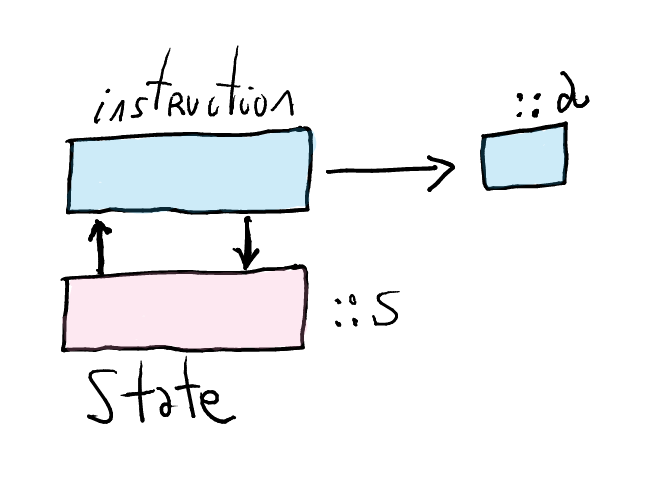
An instruction produces some result, but also read or write into the state.
Separating the reading and writing actions in the state, we can draw the graphics above as follows:
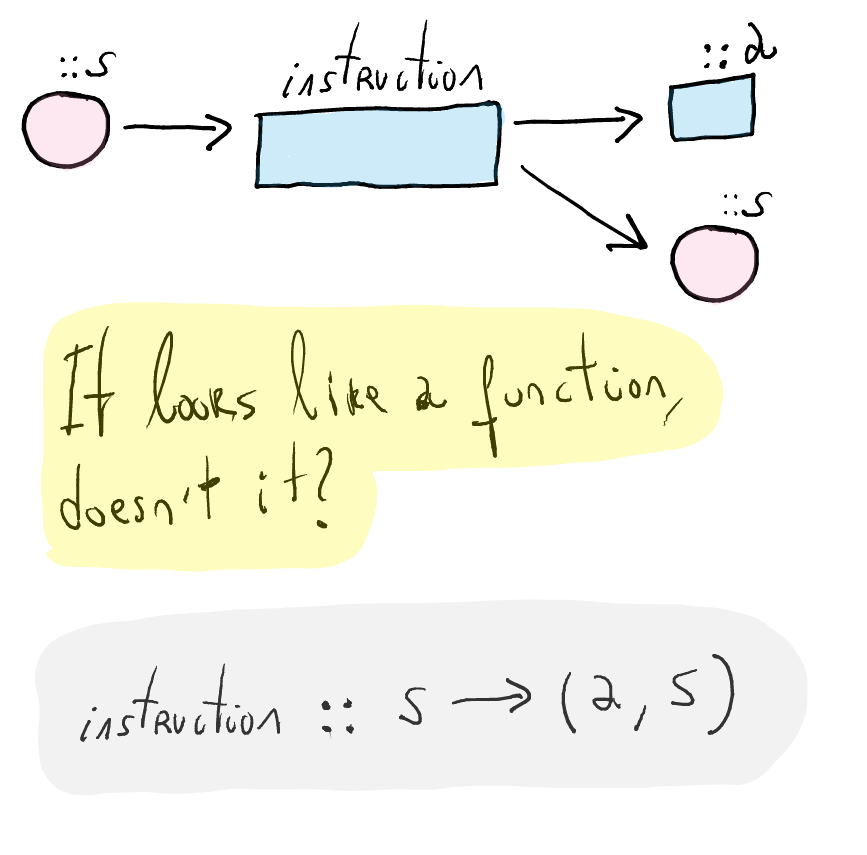
An instruction in the state monad is a function!
- This reflects the fact that it depends on the state
A program, i.e., a sequence of instructions built with the monadic operations, is also a function of type
s -> (a, s).More concretely,
newtype St s a = MkSt { runSt :: s -> (a, s) } get :: St s s get = MkSt \ s -> (s, s) put :: s -> St s () put s = MkSt \ _ -> ((), s) instance Monad (St s) where return x = MkSt \ s -> (x, s)Function
getjust places the state (receiving as an argument) as the result of the computation. Functionputignores the state given as an argument and sets the one given as an argument. Operationreturndoes not change the state and produces as a result its argument.What about
(>>=)?The definition of `(>>=)` is responsible of passing along the state from one instruction to the other.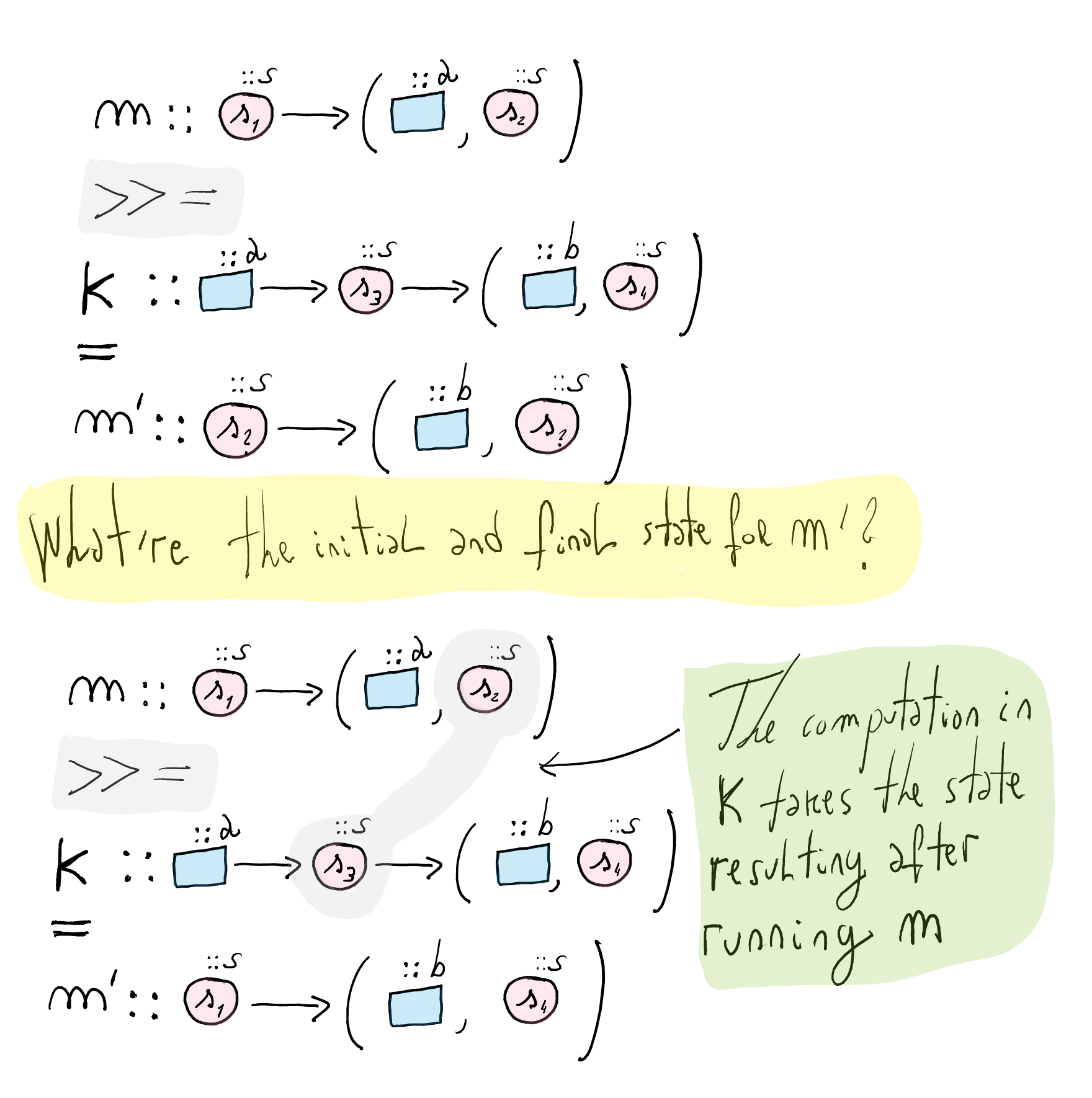
m >>= k = MkSt \ s_1 -> let (a, s_2) = runSt m s_1 in runSt (k a) s_2A possible
runfunction:m_runS :: Expr -> IO () m_runS e = do putStr "Result: " putStrLn $ show result putStrLn "Number divisions:" putStrLn $ show final_st where init_st = 0 (result, final_st) = runSt (interpS e) init_st
Monads so far
Imperative side-effects
- Error handling
- Logging
- State
The concept of monads goes beyond that
- Security
- Probability programming
- Non-determinism
- Software transactional memory
We will see more of these monads later in the course.
What about combining effects?
- State, error, and logging!
- Next lecture